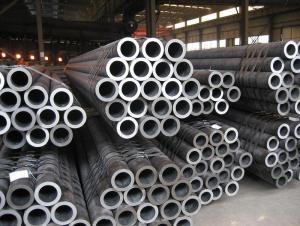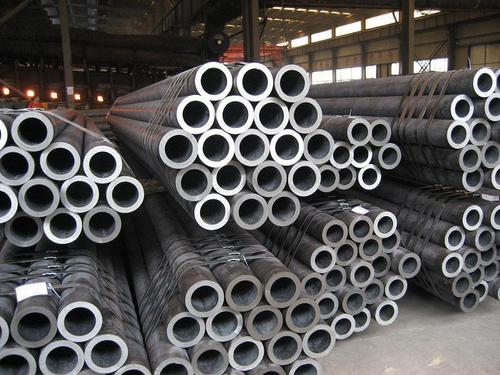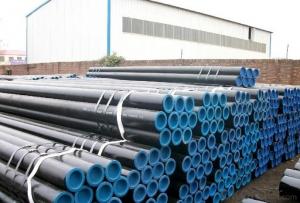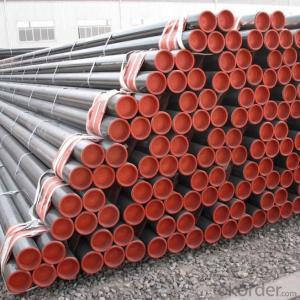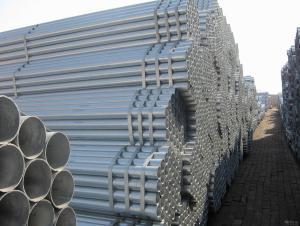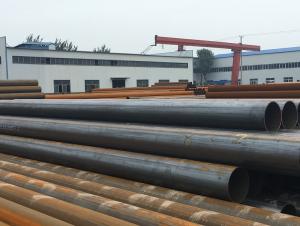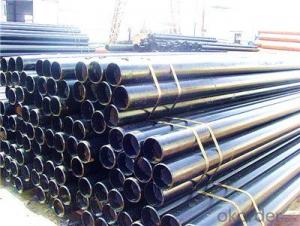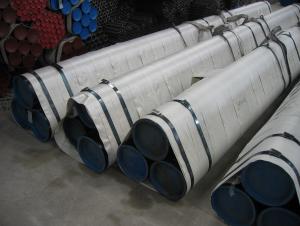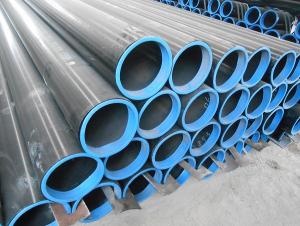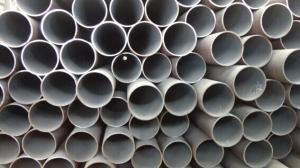Hot rolled seamless tube
- Loading Port:
- China Main Port
- Payment Terms:
- TT OR LC
- Min Order Qty:
- -
- Supply Capability:
- -
OKorder Service Pledge
OKorder Financial Service
You Might Also Like
Seamless pipe is a hollow section, no surrounding joint strip steel. The worldproduction of seamless pipe, a total of more than 5100 production plant more than 1850 companies in more than 110 countries under the production of oilpipe, which has more than 260 factory more than 170 companies in 44 countries under the.
Seamless tube with 1 structure (GB/T8162-2008) is used for seamless tubegeneral structure and mechanical structure.
Seamless pipe 2 fluid transport (GB/T8163-2008) is used for general seamless pipe conveying water, oil, gas and other fluid.
For low and medium pressure boiler seamless pipe 3 (GB3087-2008) is used in the manufacture of various structure of low and medium pressure boilersuperheated steam pipe, superheated steam pipe, boiling water pipe andlocomotive boiler flue tube, small pipe and brick arch tubes of high-quality carbon structural steel hot-rolled and cold drawn seamless pipe (rolling).
High pressure boiler seamless pipe with 4 (GB5310-2008) is used for heating surface tube boiler manufacturing high and higher pressure of high quality carbon steel, alloy steel and heat resisting stainless steel seamless pipe.
High pressure seamless tube with 5 chemical fertilizer equipment (GB6479-2000) is suitable for the work temperature of high quality carbon structural steel and alloy steel seamless tube of -40~400 DEG C, the working pressurefor chemical equipment and pipeline of 10~30Ma.
Seamless tube with 6 petroleum cracking (GB9948-2006) is applied to the oil refinery furnace tubes, heat exchangers and pipe seamless pipe.
Steel pipe 7 geological drilling (YB235-70) is for the Geological Department of the steel core drilling is used, according to use can be divided into the drill pipe, drill collar, core pipe, casing and sedimentation tubes.
Seamless tube with 8 diamond core drilling (GB3423-82) is used for seamlessdrill pipe, casing, Yan Xingan diamond core drilling.
9 oil drilling pipe (YB528-65) is used for seamless oil drilling internal upset ends or the outer thickening.
Seamless tube
Seamless tube
10 ships for carbon steel seamless pipe (GB5312-85)
China classification society rules for materials and welding -- ChineseClassification Society (CCS)
The Norway Classification Society (DNV) specification -- Norway Classification Society (DNV)
Lloyd's register of shipping (LR) specification -- British Lloyd's register of shipping (LR)
Germanischer Lloyd (GL) specification -- Germanischer Lloyd (GL)
American Classification Society (ABS) specification -- USA Classification Society (ABS)
Bureau Veritas (BV) specification -- French Classification Society (BV)
The Italy Classification Society (RINA) specification -- Italy Classification Society (RINA)
The Japanese classification society (NK) specification -- the Japaneseclassification society (NK)
The ship is making I level pressure piping, II level pressure piping, boiler and superheater for carbon steel seamless pipe. Carbon steel seamless pipe walltemperature does not exceed 450 degrees, alloy steel seamless pipe walltemperature more than 450 DEG C.
11 of automobile half shaft sleeve pipe seamless pipe (GB3088-82) is the manufacture of automobile half shaft sleeve and the driving bridge shell axis effective quality carbon structural steel and alloy structural steel hot-rolled seamless tube.
High pressure oil pipe with 12 diesel engine (GB3093-86) is a cold drawn seamless pipe manufacturing high-pressure diesel injection systems for.
With precision internal diameter seamless pipe 13 for hydraulic and pneumatic cylinder (GB8713-88) is the manufacture of hydraulic and pneumatic cylinderwith precision diameter with cold drawn or cold rolled precision seamless tube.
14 cold drawn or cold rolled precision seamless pipe (GB3639-83) is used fordimensional precision mechanical structure, hydraulic equipment, high and good surface finish of cold drawn or cold rolled precision seamless tube.Selection of precision seamless tube manufacturing mechanical or hydraulic equipment.
Stainless steel seamless tube with 15 structure (GB/T14975-2002) is widely used in chemical, petroleum, made of stainless steel hot-rolled textile, medical,food, machinery and other industrial anti-corrosion pipes and structural partsand components of a (extrusion, expansion) and cold drawing (rolling)seamless pipe.
Stainless steel seamless tube 16 fluid transport (GB/T14976-2002) is used for the transmission fluid made of stainless steel hot-rolled (extrusion, expansion)and cold drawing (rolling) seamless pipe.
17 special seamless tube is in addition to general seamless other cross section shapes of circular pipe outside the. According to the section of the steel pipe of different shapes and sizes can be divided into equal wall thickness of seamless pipe (codenamed D), unequal wall thickness of seamless pipe (codenamed BD), variable diameter special-shaped seamlesspipe (codenamed BJ). Shaped seamless pipe is widely used for variousstructural parts, tools and machinery parts.
Seamless steel tubes for 18 cryogenic pipe (GB/T18984-2003) is the use ofseamless steel tube for -45 to -195 DEG C low-temperature pressure vessellevel and low temperature heat exchanger tubes
General seamless tube is made with 10, 20, 30, 35 and 45 carbon steel 16Mnand 5MnV low alloy structural steel or 40Cr, 30CrMnSi, 45Mn2, 40MnB and other alloy steel hot-rolled or cold-rolled made. 10 and 20 low carbon steelseamless pipe is mainly used for fluid conveying pipeline. In 45, 40Cr in carbon steel seamless pipe used to make machine parts, such as automobile, tractorparts under stress. General seamless pipe to ensure the strength andflattening test. Hot rolled steel pipe in hot state or heat treatment delivery; cold with heat to heat treatment delivery. Seamless steel tubes for low and medium pressure boiler: used in the manufacture of a variety of low and medium pressure boiler, the superheated steam tube, boiling water pipe, superheated steam pipe, water wall tube and locomotive boiler flue tube, pipe and pipe arch bricks.
With high-quality carbon structural steel hot-rolled or cold-rolled seamless pipe(dial). Mainly used in 10, 20 steel manufacturing, in addition to ensure that the chemical composition and mechanical properties of the outer do pressure test,curling, flaring, flattening test. Hot rolled in hot state delivery, Leng Zha(allocated) to heat treatment delivery. Jiangyin Lubao Pipe Industry Co., Ltd. to provide seamless management of weight: seamless management of formula:(outside diameter and wall thickness) * wall thickness * 0.02466= seamless pipe weight per meter kg}
- Q: How do you prevent steel pipes from rusting?
- To prevent steel pipes from rusting, various measures can be taken. One effective method is to apply a protective coating on the surface of the pipes. This can be done using different types of coatings such as paint, epoxy, or zinc. These coatings act as a barrier between the steel and the corrosive environment, preventing moisture and oxygen from coming into direct contact with the metal and causing rust. Another approach is to use corrosion inhibitors. These substances are added to the water or fluid flowing through the pipes to create a protective film on the steel's surface. This film acts as a shield, inhibiting the corrosion process and preventing rust formation. Regular maintenance is crucial in preventing rust on steel pipes. This includes inspecting the pipes for any signs of damage or corrosion and promptly repairing or replacing any compromised areas. Additionally, keeping the pipes clean and dry by removing any accumulated dirt or moisture helps to prevent rust formation. In some cases, it may be beneficial to use stainless steel pipes instead of regular steel. Stainless steel contains chromium, which forms a passive oxide layer on the surface of the metal. This layer acts as a natural barrier against corrosion, making stainless steel pipes highly resistant to rust. Lastly, controlling the environment in which the pipes are installed can also help prevent rust. This can be achieved by maintaining proper ventilation, controlling humidity levels, and avoiding exposure to harsh chemicals or corrosive substances. By implementing these preventive measures, the lifespan and integrity of steel pipes can be significantly extended while minimizing the risk of rust formation.
- Q: Can steel pipes be used for both high-pressure and low-pressure systems?
- Yes, steel pipes can be used for both high-pressure and low-pressure systems. Steel is known for its durability, strength, and resistance to extreme conditions, making it suitable for various applications. Whether it is transporting liquids or gases in high-pressure systems or low-pressure systems, steel pipes can efficiently handle the demands of both.
- Q: Can steel pipes be used for transporting drinking water?
- Yes, steel pipes can be used for transporting drinking water. Steel pipes are commonly used in water distribution systems and have been used for many years. They are known for their durability, strength, and resistance to corrosion. However, it is important to ensure that the steel pipes used for transporting drinking water are properly coated or lined to prevent any potential contamination from the metal. Additionally, regular inspections and maintenance should be carried out to ensure the integrity of the pipes and to prevent any leaks or breaks that could compromise the quality of the water.
- Q: How are steel pipes used in the manufacturing of structural frameworks?
- Steel pipes are commonly used in the manufacturing of structural frameworks due to their strength, durability, and versatility. They provide a reliable means of connecting and supporting various components, allowing for the creation of robust and stable structures. Steel pipes are often used as columns, beams, and braces, providing essential support and stability to buildings, bridges, and other infrastructure projects. Additionally, steel pipes can be easily customized and fabricated to meet specific design requirements, making them a popular choice in the construction industry.
- Q: How are steel pipes protected against corrosion?
- Steel pipes are protected against corrosion through various methods such as applying protective coatings, galvanizing, cathodic protection, and using corrosion inhibitors.
- Q: What are the different standards for steel pipe manufacturing?
- There are several standards for steel pipe manufacturing, including ASTM (American Society for Testing and Materials), API (American Petroleum Institute), DIN (Deutsches Institut für Normung), and JIS (Japanese Industrial Standards). These standards define the specifications for various aspects of steel pipe production, such as dimensions, material composition, mechanical properties, and testing procedures. Compliance with these standards ensures the quality and reliability of steel pipes for different applications, ranging from construction and infrastructure to oil and gas industries.
- Q: Are steel pipes suitable for use in nuclear power plants?
- Yes, steel pipes are suitable for use in nuclear power plants. They are commonly used in various systems such as cooling, steam, and reactor coolant systems due to their high strength, durability, and resistance to corrosion. Additionally, steel pipes can withstand the high pressure and temperature conditions present in nuclear power plants, making them a reliable choice for this critical infrastructure.
- Q: What are the different types of steel pipe coatings?
- There are several types of steel pipe coatings, including epoxy coatings, polyethylene coatings, polyurethane coatings, and zinc coatings. These coatings help protect the steel pipes from corrosion, increase their lifespan, and improve their performance in various environments.
- Q: What are the factors to consider when selecting steel pipes?
- Some factors to consider when selecting steel pipes include the intended application and environment, the required strength and durability, the size and thickness of the pipes, the corrosion resistance, the cost, and the availability of different types of steel pipes.
- Q: How are steel pipes used in sewage systems?
- Steel pipes are commonly used in sewage systems for their strength, durability, and resistance to corrosion. These pipes are used to transport sewage and wastewater from homes, businesses, and industrial facilities to treatment plants or disposal sites. They are ideal for underground installations due to their ability to withstand high pressure and the weight of the surrounding soil. Additionally, steel pipes can be welded together, providing a seamless and leak-proof system that ensures the safe and efficient transportation of sewage.
Send your message to us
Hot rolled seamless tube
- Loading Port:
- China Main Port
- Payment Terms:
- TT OR LC
- Min Order Qty:
- -
- Supply Capability:
- -
OKorder Service Pledge
OKorder Financial Service
Similar products
Hot products
Hot Searches
Related keywords
